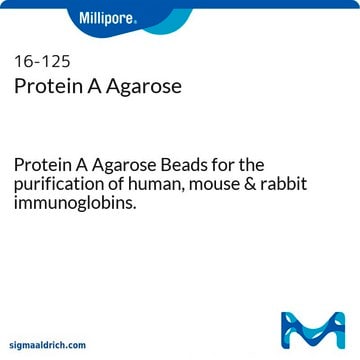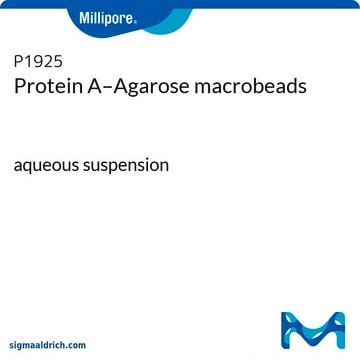PROTAA-RO
Roche
Protein A Agarose
>98% (HPLC and SDS-PAGE), suspension
Sinônimo(s):
agarose, protein a
Selecione um tamanho
R$ 1.600,00
Selecione um tamanho
About This Item
R$ 1.600,00
Produtos recomendados
Ensaio
>98% (HPLC and SDS-PAGE)
Formulário
suspension
embalagem
pkg of 15 mL (05015979001 [settled resin volume])
pkg of 2 mL (11719408001 [settled resin volume])
pkg of 5 mL (11134515001 [settled resin volume])
fabricante/nome comercial
Roche
capacidade
>18 mg/mL binding capacity (human IgG (polyclonal))(the IgG is loaded at pH 7.4 and eluted with 200 mM glycine, pH 2.0)
temperatura de armazenamento
2-8°C
Descrição geral
Protein A leakage: <18 ng Protein A/ml (ELISA)
Regeneration: the gel can be used approximately 30 times
Structure: recombinant Protein A (E. coli, Mr = 45,000) is covalently coupled to crosslinked 6% agarose beads: 3 mg Protein A (>98% pure, HPLC, SDS-Page)/1 ml gel
Protein A, immobilized.
Especificidade
Aplicação
Componentes
Protein A content: 3 mg/ml pre-swollen gel
Qualidade
Outras notas
Palavra indicadora
Warning
Frases de perigo
Declarações de precaução
Classificações de perigo
Eye Irrit. 2 - Flam. Liq. 3
Código de classe de armazenamento
3 - Flammable liquids
Classe de risco de água (WGK)
WGK 1
Ponto de fulgor (°F)
102.2 °F
Ponto de fulgor (°C)
39 °C
Escolha uma das versões mais recentes:
Já possui este produto?
Encontre a documentação dos produtos que você adquiriu recentemente na biblioteca de documentos.
Nossa equipe de cientistas tem experiência em todas as áreas de pesquisa, incluindo Life Sciences, ciência de materiais, síntese química, cromatografia, química analítica e muitas outras.
Entre em contato com a assistência técnica










